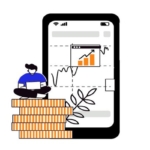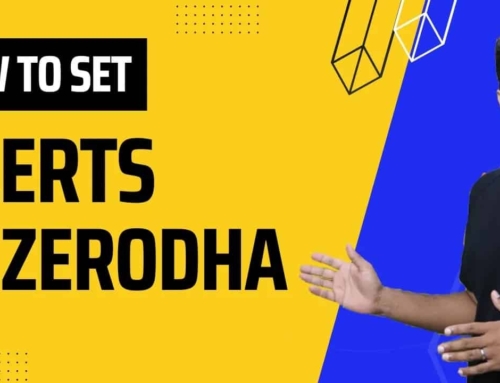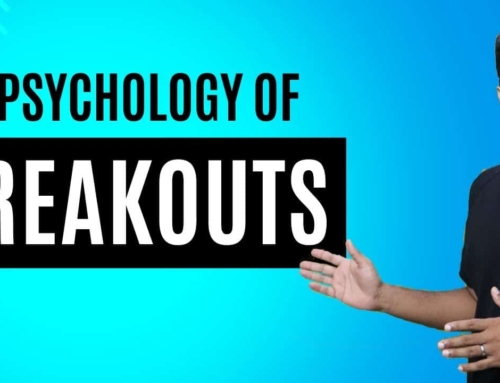What are Bracket orders? Should You Use Them?
Introduction
Bracket orders are very popular in India, mainly because they offer very high leverage.
Unfortunately, that’s the only aspect most traders think about.
In this session, we will discuss some very important facts you need to know before using bracket orders.
First thing first, what are bracket orders?
Bracket orders are three orders packed into one.
So, if you placed an order to buy a stock at 100 rupees. Along with that, you will also have to place two more orders.
One of them is called the target order or the profit order, which tells the system that if the stock goes up to a certain level, say 130 in this case, I want to book my profit. So, if the stock does go up to 130, that order will be automatically triggered and you will book your profit.
The other order you have to place is called a “stop-loss” order. In case the trade is not working out, you want to limit your losses. So by placing a stop-loss order, say at 95, you are telling the system that I don’t want to stay in the trade and take bigger losses if the stock falls below 95.
So, all these three orders, namely, your original buy order, target order for booking profit and stop-loss order for cutting losses put together in one bundle are called “bracket order”.
One of the interesting features of bracket orders is that between the target order and stop-loss if any one of them gets triggered, the other gets cancelled automatically. So, if your trade worked out in your favour and the target order got executed at Rs.130, the stop loss order will automatically get cancelled. You don’t have to manually go and cancel it. On the other hand, if the stock goes against you and the stop-loss order gets triggered, the target order will automatically be cancelled.
It may not look like a big positive, but trust me, I have seen a lot of people who leave pending orders in the system and those pending orders get accidentally triggered without their knowledge, causing some significant losses.
Let’s take a live example to see what a bracket order looks like in Zerodha
So, for this live example, we are going to place a bracket order on Bank of Baroda from Zerodha’s Kite terminal. Let’s just add it to the market watch and here is its chart. I identify the key support and resistance, then decide to place a buy bracket order. Click on “Buy”, enter the quantity and now, here, click on the “more options” and here it is- bracket order.
We will not spend too much time on the live demo because that’s covered in another tutorial.
The next thing we need to understand is that why does Bracket order have higher leverage?
Leverage, that is the ability to take trades much higher than your trading capital, is provided by your broker, like Zerodha, Sharekhan, ICICI Securities etc. They are loaning you money to take bigger trades.
The reason these brokers provide higher leverage to bracket orders as compared to a regular intraday order is because of this… right here. You see, when you place a bracket order, it is mandatory to specify the stop loss. Not only that, the stop loss has to stay within 2% of the entry price.
So because of these strict stop losses, the brokers can be assured that you will not incur losses more than your trading capital. Hence, the risk to the broker is limited and clearly defined, and the fact that these are intraday orders with no overnight risk, brokers give 10 x, 20x and even 40x times leverage for bracket orders.
Advantages of using Bracket Orders:
The biggest and the most obvious benefit of bracket orders is the leverage they provide. As I mentioned earlier, some brokers even offer 40 times leverage for bracket orders. For those with relatively low trading capital, bracket orders provide hope that they can generate decent returns from the market even with modest capital.
The second thing that I like about Bracket orders is the feature of trailing stop losses. When the stock starts moving in our direction, with the help of trailing stop loss, we can automatically keep moving the stop losses as well, hence protecting our profits.
In our case, assume that we define the trailing stop loss as 10. If the stock starts up, from 100 to 110, the stop loss will automatically move up from 90 to 100. When this happens, you have protected your downside by 10 points automatically. In the same way, if the stock goes to 120, the stop loss will up to 110…so on and so forth.
The third which is more of an operational benefit of bracket orders is that you don’t have to keep monitoring them. Since the target and stop-loss orders are already present, you know exactly what is the maximum profit and loss that’s possible in that trade.
So, if you have to step out of your house or do something, these orders pretty much take care of themselves. Further, brokers like Zerodha auto square off these orders towards the close of the market and so you don’t have to worry about closing your position as well.
So, these were the benefits of bracket orders.
Disadvantages of using bracket orders:
The biggest disadvantage of bracket orders is that many traders, especially beginners, take excessive risks in trades and hence lose a lot of money. I have seen traders take Rs.20 lakh worth of trade with only Rs.1 lakh capital and yes…these do go wrong very quickly because even a slight adverse movement can easily scare the trades out of the position. I have seen people losing 20%, 50% and even 80% of their capital in a day and a single trade.
Now, technically it is not the fault of the bracket orders as much it is the fault of the traders. The fact is that bracket orders are misused heavily and the temptation to make quick money kills the careers of several budding traders.
The second limitation of bracket orders is that they cannot be placed for most of the options trading. As of today, Zerodha doesn’t offer bracket orders for Bank nifty options, stock options, currency options and commodity options. These rules might be different for different brokers but I have seen restrictions like these with almost every broker.
The third thing that I don’t like about bracket orders is the brokerage charges. Remember, how I said that your one order can be executed in several legs? Well, the bad news is that brokers like Zerodha charge brokerage on every leg of execution. So, if your one order of 1000 units is executed in parts, you will have to pay 5 times brokerage. That is not the case with the regular MIS orders. So, you have to watch out for the brokerage charges as well.
The fourth con is more of an experience. Several traders that I work with have reported issues modifying and exiting the bracket orders. It can be frustrating when you want to modify your target or bracket order but the system is not responding. Again, this is experience-based and I don’t have any empirical evidence for this but just be cautious when dealing with bracket orders.
The fifth con is that modifying and exiting from a position can become very tricky if the order got executed in several legs. You have to manually go and update every single order and that can get annoying or cumbersome and sometimes be very late.
Conclusion
#1: If you are someone who has a problem controlling your emotions and tends to take much bigger losses than originally planned, I think bracket orders are great for you. Since stop-loss is mandatory, it will force you to cut a bad position as soon as the predefined limit is reached.
#2 Before using bracket orders for large trading quantities, test them out with smaller quantities and see if you are satisfied with the way they work. As I mentioned, you will have to deal with multiple legs of the same trade, and probably will encounter some technical issues. Instead of getting frustrated or stuck in a large trade, better make sure you know how to deal with such situations.
#3 Don’t be greedy. I know it is obvious but the reality is that every day thousands of traders take excessive leverage because their brokers allow them to. Think about it like this. If you go to a buffet that offers unlimited liquor, should you be drinking much more than your capacity? No, right. Remember that leverage might be free from the broker but it’s still your money on the line. It doesn’t matter what leverage the broker offers, you should not be taking trades beyond your risk tolerance capacity.
Alright, guys, this is it. Hope you learned something new today. Also, if you’re new, go ahead and subscribe to the channel because we are making this channel India’s biggest online library of stock market videos. Stay tuned.
Key Takeaways
1- Insider trading refers to buying and selling securities (e.g. stocks) based on confidential information that is not available to general public
2- Every year, there are several cases of insider trading that come to light and there are hundreds more that go unnoticed.
3- SEBI (our stock market regulator) has been getting strict about dealing with insider trading.
4- SEBI has made insider trading punishable by imprisonment up to 10 years or a fine upto 25 crores
Howdy!
If you’re here for the first time, let’s get introduced.
VRD Nation is India’s premier stock market training institute and we (Team VRD Nation) are passionate about teaching each and every aspect of investing and trading.
If you’re here for the first time, don’t forget to check out “Free Training” section where we have tons of free videos and articles to kick start your stock market journey.
Also, we got two awesome YouTube channels where you can continue the learning process.
Must-Read Articles
What are Bracket orders? Should You Use Them?
Introduction
Bracket orders are very popular in India, mainly because they offer very high leverage.
Unfortunately, that’s the only aspect most traders think about.
In this session, we will discuss some very important facts you need to know before using bracket orders.
First thing first, what are bracket orders?
Bracket orders are three orders packed into one.
So, if you placed an order to buy a stock at 100 rupees. Along with that, you will also have to place two more orders.
One of them is called the target order or the profit order, which tells the system that if the stock goes up to a certain level, say 130 in this case, I want to book my profit. So, if the stock does go up to 130, that order will be automatically triggered and you will book your profit.
The other order you have to place is called a “stop-loss” order. In case the trade is not working out, you want to limit your losses. So by placing a stop-loss order, say at 95, you are telling the system that I don’t want to stay in the trade and take bigger losses if the stock falls below 95.
So, all these three orders, namely, your original buy order, target order for booking profit and stop-loss order for cutting losses put together in one bundle are called “bracket order”.
One of the interesting features of bracket orders is that between the target order and stop-loss if any one of them gets triggered, the other gets cancelled automatically. So, if your trade worked out in your favour and the target order got executed at Rs.130, the stop loss order will automatically get cancelled. You don’t have to manually go and cancel it. On the other hand, if the stock goes against you and the stop-loss order gets triggered, the target order will automatically be cancelled.
It may not look like a big positive, but trust me, I have seen a lot of people who leave pending orders in the system and those pending orders get accidentally triggered without their knowledge, causing some significant losses.
Let’s take a live example to see what a bracket order looks like in Zerodha
So, for this live example, we are going to place a bracket order on Bank of Baroda from Zerodha’s Kite terminal. Let’s just add it to the market watch and here is its chart. I identify the key support and resistance, then decide to place a buy bracket order. Click on “Buy”, enter the quantity and now, here, click on the “more options” and here it is- bracket order.
We will not spend too much time on the live demo because that’s covered in another tutorial.
The next thing we need to understand is that why does Bracket order have higher leverage?
Leverage, that is the ability to take trades much higher than your trading capital, is provided by your broker, like Zerodha, Sharekhan, ICICI Securities etc. They are loaning you money to take bigger trades.
The reason these brokers provide higher leverage to bracket orders as compared to a regular intraday order is because of this… right here. You see, when you place a bracket order, it is mandatory to specify the stop loss. Not only that, the stop loss has to stay within 2% of the entry price.
So because of these strict stop losses, the brokers can be assured that you will not incur losses more than your trading capital. Hence, the risk to the broker is limited and clearly defined, and the fact that these are intraday orders with no overnight risk, brokers give 10 x, 20x and even 40x times leverage for bracket orders.
Advantages of using Bracket Orders:
The biggest and the most obvious benefit of bracket orders is the leverage they provide. As I mentioned earlier, some brokers even offer 40 times leverage for bracket orders. For those with relatively low trading capital, bracket orders provide hope that they can generate decent returns from the market even with modest capital.
The second thing that I like about Bracket orders is the feature of trailing stop losses. When the stock starts moving in our direction, with the help of trailing stop loss, we can automatically keep moving the stop losses as well, hence protecting our profits.
In our case, assume that we define the trailing stop loss as 10. If the stock starts up, from 100 to 110, the stop loss will automatically move up from 90 to 100. When this happens, you have protected your downside by 10 points automatically. In the same way, if the stock goes to 120, the stop loss will up to 110…so on and so forth.
The third which is more of an operational benefit of bracket orders is that you don’t have to keep monitoring them. Since the target and stop-loss orders are already present, you know exactly what is the maximum profit and loss that’s possible in that trade.
So, if you have to step out of your house or do something, these orders pretty much take care of themselves. Further, brokers like Zerodha auto square off these orders towards the close of the market and so you don’t have to worry about closing your position as well.
So, these were the benefits of bracket orders.
Disadvantages of using bracket orders:
The biggest disadvantage of bracket orders is that many traders, especially beginners, take excessive risks in trades and hence lose a lot of money. I have seen traders take Rs.20 lakh worth of trade with only Rs.1 lakh capital and yes…these do go wrong very quickly because even a slight adverse movement can easily scare the trades out of the position. I have seen people losing 20%, 50% and even 80% of their capital in a day and a single trade.
Now, technically it is not the fault of the bracket orders as much it is the fault of the traders. The fact is that bracket orders are misused heavily and the temptation to make quick money kills the careers of several budding traders.
The second limitation of bracket orders is that they cannot be placed for most of the options trading. As of today, Zerodha doesn’t offer bracket orders for Bank nifty options, stock options, currency options and commodity options. These rules might be different for different brokers but I have seen restrictions like these with almost every broker.
The third thing that I don’t like about bracket orders is the brokerage charges. Remember, how I said that your one order can be executed in several legs? Well, the bad news is that brokers like Zerodha charge brokerage on every leg of execution. So, if your one order of 1000 units is executed in parts, you will have to pay 5 times brokerage. That is not the case with the regular MIS orders. So, you have to watch out for the brokerage charges as well.
The fourth con is more of an experience. Several traders that I work with have reported issues modifying and exiting the bracket orders. It can be frustrating when you want to modify your target or bracket order but the system is not responding. Again, this is experience-based and I don’t have any empirical evidence for this but just be cautious when dealing with bracket orders.
The fifth con is that modifying and exiting from a position can become very tricky if the order got executed in several legs. You have to manually go and update every single order and that can get annoying or cumbersome and sometimes be very late.
Conclusion
#1: If you are someone who has a problem controlling your emotions and tends to take much bigger losses than originally planned, I think bracket orders are great for you. Since stop-loss is mandatory, it will force you to cut a bad position as soon as the predefined limit is reached.
#2 Before using bracket orders for large trading quantities, test them out with smaller quantities and see if you are satisfied with the way they work. As I mentioned, you will have to deal with multiple legs of the same trade, and probably will encounter some technical issues. Instead of getting frustrated or stuck in a large trade, better make sure you know how to deal with such situations.
#3 Don’t be greedy. I know it is obvious but the reality is that every day thousands of traders take excessive leverage because their brokers allow them to. Think about it like this. If you go to a buffet that offers unlimited liquor, should you be drinking much more than your capacity? No, right. Remember that leverage might be free from the broker but it’s still your money on the line. It doesn’t matter what leverage the broker offers, you should not be taking trades beyond your risk tolerance capacity.
Alright, guys, this is it. Hope you learned something new today. Also, if you’re new, go ahead and subscribe to the channel because we are making this channel India’s biggest online library of stock market videos. Stay tuned.
Key Takeaways
1- Insider trading refers to buying and selling securities (e.g. stocks) based on confidential information that is not available to general public
2- Every year, there are several cases of insider trading that come to light and there are hundreds more that go unnoticed.
3- SEBI (our stock market regulator) has been getting strict about dealing with insider trading.
4- SEBI has made insider trading punishable by imprisonment up to 10 years or a fine upto 25 crores















![What is Virtual Contract Note [Zerodha]](https://www.vrdnation.com/wp-content/uploads/2023/10/maxresdefault-virtual-note-500x383.jpg)



Is On line coaching available
In bracket order, what if i dont achieve the target
eg – price-200, stop loss-195, target-210
In the end of the day price would come to 206 than would I get profit of 6 rupee per share or the order automatically gets canceled